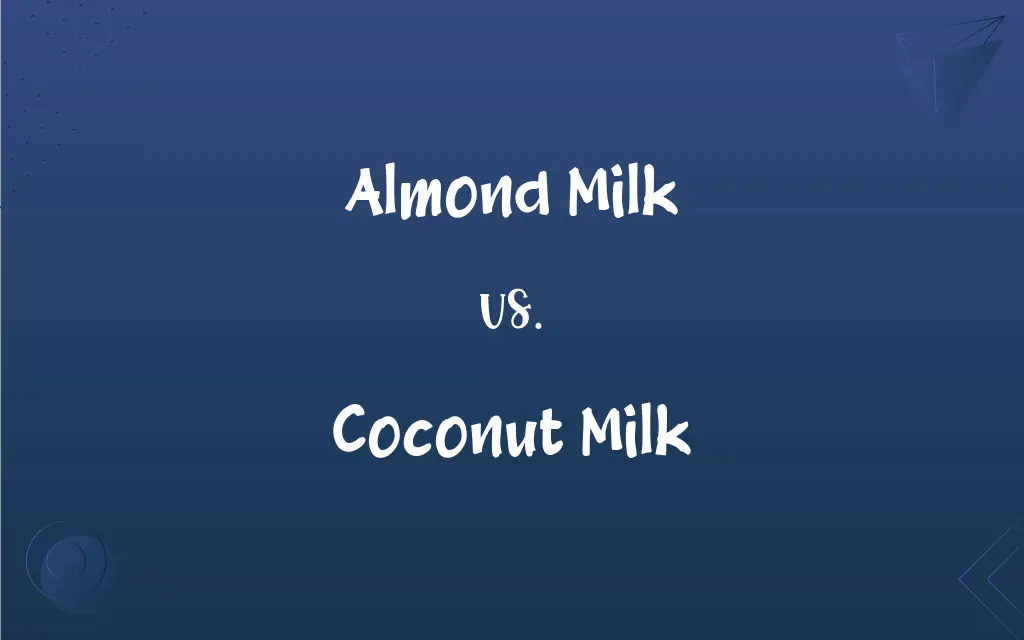Almond Milk vs. Coconut Milk: What's the Difference?
Edited by Aimie Carlson || By Harlon Moss || Updated on October 25, 2023
Almond milk is a dairy-free drink made from blended almonds and water, while coconut milk is a creamy liquid derived from the flesh of coconuts.

Key Differences
Almond milk is derived primarily from almonds, which are ground and then mixed with water. Coconut milk, on the other hand, is extracted from the flesh or meat of mature coconuts.
Almond milk usually possesses a light, nutty flavor, making it a favorite for many cereals and coffee mixes. Coconut milk, conversely, boasts a rich, creamy consistency with a tropical flavor, often used in culinary dishes.
From a nutritional perspective, almond milk is typically lower in calories and fat compared to coconut milk. Coconut milk, however, contains medium-chain triglycerides (MCTs), which have various health benefits.
In terms of usage, almond milk is often consumed as a milk substitute in beverages and cereals. Coconut milk is frequently incorporated in cooking, especially in Asian and tropical cuisines, because of its distinct taste and creamy texture.
Both almond milk and coconut milk are popular dairy alternatives. While almond milk is often favored for its mild flavor in everyday beverages, coconut milk is prized for its rich consistency in savory and sweet dishes.
ADVERTISEMENT
Comparison Chart
Source
Ground almonds and water.
Flesh or meat of mature coconuts.
Flavor & Consistency
Light, nutty, and slightly creamy.
Rich, creamy, and tropical.
Nutritional Profile
Lower in calories and fat.
Higher in fat, contains MCTs.
Common Usage
Beverages, cereals.
Cooking, especially Asian and tropical dishes
Appearance
Often lighter, similar to dairy milk.
Thicker, creamy texture.
ADVERTISEMENT
Almond Milk and Coconut Milk Definitions
Almond Milk
Almond milk is often fortified with vitamins and minerals.
The fortified almond milk provides her with necessary calcium and vitamin D.
Coconut Milk
Coconut milk contains beneficial medium-chain triglycerides.
He adds coconut milk to his diet for its MCT content.
Almond Milk
Almond milk serves as a dairy alternative in various dishes.
This recipe uses almond milk instead of cow's milk for a vegan touch.
Coconut Milk
Coconut milk is a creamy liquid extracted from coconut flesh.
The curry had a rich flavor thanks to the coconut milk.
Almond Milk
Almond milk possesses a mild, nutty flavor.
The nutty hint in the dessert was thanks to the almond milk.
Coconut Milk
Coconut milk has a distinct tropical flavor.
The dessert's tropical touch comes from the coconut milk.
Almond Milk
Almond milk is a drink made from ground almonds and water.
She prefers almond milk in her morning coffee for its light texture.
Coconut Milk
Coconut milk is often canned or available in cartons.
She bought a can of coconut milk for her weekend cooking.
Almond Milk
Almond milk is typically lower in fat and calories.
For a healthier option, he chose almond milk for his smoothie.
Coconut Milk
Coconut milk is a staple in many Asian and tropical cuisines.
The Thai soup uses coconut milk for its signature creamy consistency.
FAQs
Can I use almond milk in cooking?
Yes, almond milk can be used in cooking, but it may alter the dish's flavor and consistency compared to coconut milk.
Is coconut milk good for curries?
Yes, coconut milk is commonly used in curries for its creamy texture and flavor.
Are both milks dairy-free?
Yes, both almond milk and coconut milk are dairy-free alternatives.
What is almond milk made from?
Almond milk is made from ground almonds and water.
Which milk is lower in calories?
Almond milk is typically lower in calories compared to coconut milk.
How is coconut milk produced?
Coconut milk is extracted from the flesh of mature coconuts.
Can I make almond milk at home?
Yes, almond milk can be made by blending soaked almonds with water and straining the mixture.
Is almond milk gluten-free?
Pure almond milk is gluten-free, but always check the label for any additives.
How is light coconut milk different?
Light coconut milk has less fat as it's diluted more than regular coconut milk.
Are there unsweetened versions of almond milk?
Yes, many brands offer unsweetened almond milk without added sugars.
Which milk is lighter in flavor?
Almond milk generally has a lighter, nutty flavor compared to the rich taste of coconut milk.
Which milk is better for coffee?
It's subjective, but almond milk is often preferred in coffee for its light texture.
How long can I store opened coconut milk?
Opened coconut milk should be refrigerated and used within a few days.
Which milk has a creamier texture?
Coconut milk typically has a creamier texture compared to almond milk.
Is there a difference between almond milk and almond beverage?
They're essentially the same, but some brands use the term "beverage" due to labeling regulations.
Does almond milk contain calcium?
While almonds contain calcium, many commercial almond milk brands fortify their product with additional calcium.
Does coconut milk have health benefits?
Yes, coconut milk contains MCTs and various nutrients beneficial for health.
Can coconut milk be whipped?
Yes, the creamy portion of full-fat coconut milk can be whipped like cream.
Which is more environmentally friendly to produce?
Both have environmental impacts, but almond milk production often uses more water.
Is coconut milk suitable for desserts?
Yes, coconut milk's rich texture and flavor make it ideal for many desserts.
About Author
Written by
Harlon MossHarlon is a seasoned quality moderator and accomplished content writer for Difference Wiki. An alumnus of the prestigious University of California, he earned his degree in Computer Science. Leveraging his academic background, Harlon brings a meticulous and informed perspective to his work, ensuring content accuracy and excellence.
Edited by
Aimie CarlsonAimie Carlson, holding a master's degree in English literature, is a fervent English language enthusiast. She lends her writing talents to Difference Wiki, a prominent website that specializes in comparisons, offering readers insightful analyses that both captivate and inform.































































